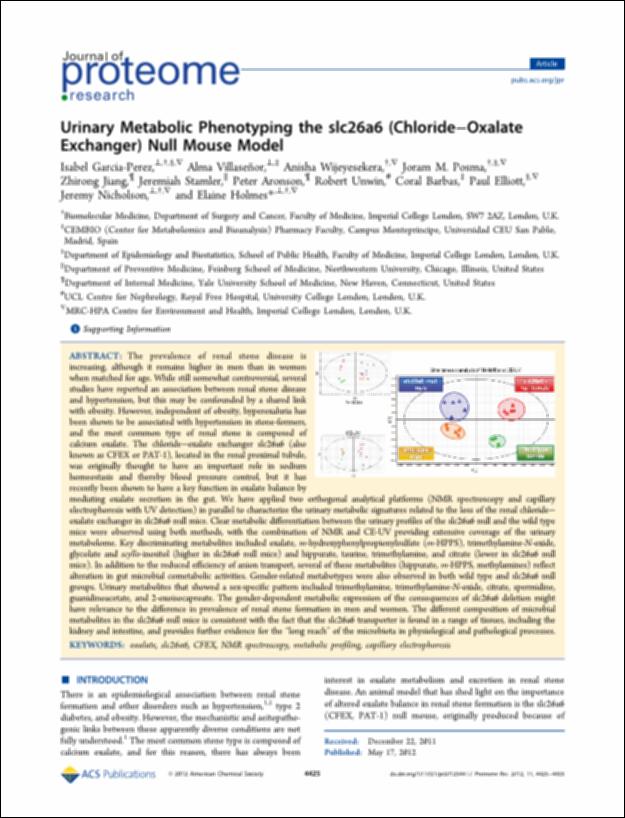Por favor, use este identificador para citar o enlazar este ítem:
http://hdl.handle.net/10637/12992Urinary Metabolic Phenotyping the slc26a6 (Chloride-Oxalate Exchanger): null mouse model.
| Título : | Urinary Metabolic Phenotyping the slc26a6 (Chloride-Oxalate Exchanger): null mouse model. |
| Autor : | Villaseñor Solis, Alma Cristina García Pérez, Isabel |
| Materias: | Oxalate.; Slc26a6.; CFEX.; NMR spectroscopy.; Metabolic profiling.; Capillary electrophoresis. |
| Resumen : | The prevalence of renal stone disease is increasing, although it remains higher in men than in women when matched for age. While still somewhat controversial, several studies have reported an association between renal stone disease and hypertension, but this may be confounded by a shared link with obesity. However, independent of obesity, hyperoxaluria has been shown to be associated with hypertension in stone-formers, and the most common type of renal stone is composed of calcium oxalate. The chloride−oxalate exchanger slc26a6 (also known as CFEX or PAT-1), located in the renal proximal tubule, was originally thought to have an important role in sodium homeostasis and thereby blood pressure control, but it has recently been shown to have a key function in oxalate balance by mediating oxalate secretion in the gut. We have applied two orthogonal analytical platforms (NMR spectroscopy and capillary electrophoresis with UV detection) in parallel to characterize the urinary metabolic signatures related to the loss of the renal chloride− oxalate exchanger in slc26a6 null mice. Clear metabolic differentiation between the urinary profiles of the slc26a6 null and the wild type mice were observed using both methods, with the combination of NMR and CE-UV providing extensive coverage of the urinary metabolome. Key discriminating metabolites included oxalate, m-hydroxyphenylpropionylsulfate (m-HPPS), trimethylamine-N-oxide, glycolate and scyllo-inositol (higher in slc26a6 null mice) and hippurate, taurine, trimethylamine, and citrate (lower in slc26a6 null mice). In addition to the reduced efficiency of anion transport, several of these metabolites (hippurate, m-HPPS, methylamines) reflect alteration in gut microbial cometabolic activities. Gender-related metabotypes were also observed in both wild type and slc26a6 null groups. Urinary metabolites that showed a sex-specific pattern included trimethylamine, trimethylamine-N-oxide, citrate, spermidine, guanidinoacetate, and 2-oxoisocaproate. The gender-dependent metabolic expression of the consequences of slc26a6 deletion might have relevance to the difference in prevalence of renal stone formation in men and women. The different composition of microbial metabolites in the slc26a6 null mice is consistent with the fact that the slc26a6 transporter is found in a range of tissues, including the kidney and intestine, and provides further evidence for the “long reach” of the microbiota in physiological and pathological processes. |
| Descripción : | Artículo en colaboración con: Alma Villasenor, Anisha Wijeyesekera, Joram M. Posma, Zhirong Jiang, Jeremiah Stamler, Peter Aronson, Robert Unwin, Coral Barbas, Paul Elliott, Jeremy Nicholson, Elaine Holmes. En: Journal of Proteome Research. ISSN 1535-3893 2012, 11 - 9, pp. 4425 - 4435 |
| URI : | http://hdl.handle.net/10637/12992 |
| Derechos: | http://creativecommons.org/licenses/by-nc-nd/4.0/deed.es |
| Fecha de publicación : | 14-sep-2012 |
| Centro : | Universidad San Pablo-CEU |
| Aparece en las colecciones: | Facultad de Farmacia |
Los ítems de DSpace están protegidos por copyright, con todos los derechos reservados, a menos que se indique lo contrario.


